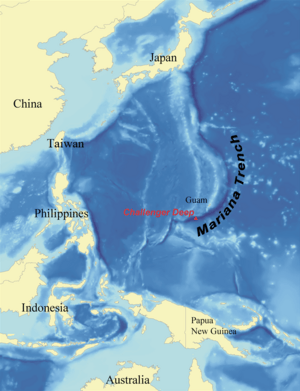Mariana Trench facts for kids
The Mariana Trench is the deepest known submarine trench. It is also the deepest known location on Earth itself. It lies south and east of the Mariana Islands, and has a depth up to 10,971 m (7 miles). The western end of the trench is near Guam.
The trench is about 2,550 kilometres (1,580 miles) long but has a mean width of only 69 kilometres (43 miles).
Contents
Challenger Deep
The deepest part of the trench is known as the Challenger Deep. It is named after the British Royal Navy survey ship HMS Challenger, whose expedition of 1872–76 made the first recordings of its depth.
A 2009 sonar mapping of the Challenger Deep from the Kilo Moana found a spot with a depth of 10,971 m (35,994 ft) (6.82 miles). The sonar system has an accuracy of better than 0.2% of water depth. Water pressure is more than a thousand times as great as at the surface.
The Challenger Deep has been reached four times by submersibles, namely the manned bathyscaphe Trieste on 23 January 1960, the unmanned robotic deep-sea probes Kaiko (Japanese) in 1995 and Nereus (U.S.) in 2009, and by James Cameron in the Deepsea Challenger on 26 March, 2012. Cameron was able to film a 3D movie of the bottom of the trench.
Lifeforms
The HMS Challenger expedition found radiolaria in the two dredged samples taken when the Challenger Deep was first discovered.
On their 1960 descent, the crew of the Trieste noted that the floor consisted of diatomaceous ooze and reported observing "some type of flatfish, resembling a sole, about 1 foot long and 6 inches across" lying on the seabed. The report has since been questioned, with suggestions that it may have been a sea cucumber. The video camera on board the Kaiko probe spotted a sea cucumber, a scale worm and a shrimp at the bottom. At the bottom of the Challenger deep, the Nereus probe spotted one polychaete worm about an inch long.
An analysis of the sediment samples collected by Kaiko found large numbers of simple organisms at 10,900 m (35,800 ft).
The overwhelming majority of the organisms collected were simple, soft-shelled foraminifera (432 species according to National Geographic).
Eighty-five percent of the specimens were organic, soft-shelled forams. This is unusual compared to samples of sediment from other deep-sea environments, where the percentage of organic-walled foraminifera ranges from 5% to 20%. As small organisms with hard, calcareous shells have trouble growing at extreme depths because of the high solubility of calcium carbonate in the pressurized water, scientists theorize that the preponderance of soft-shelled organisms in the Challenger Deep may have resulted from survivors of the biosphere present when the Challenger Deep was shallower than it is now.
Tectonic plates
The trench is one of the results of a large boundary where two oceanic tectonic plates have converged (collided).
At the boundary, the western edge of the Pacific Plate is subducted beneath the small Mariana Plate. Because the Pacific plate is the largest of all the tectonic plates on Earth, crustal material at its western edge has had up to 170 million years to compact and become very dense; hence its great height-difference relative to the higher-riding Mariana Plate, at the point where the Pacific Plate crust is subducted. This deep area is the Mariana trench proper. The movement of these plates is also responsible for the formation of the Mariana Islands.
Interesting facts about the Mariana Trench
- The Mariana Trench is named after the nearby Mariana Islands, which are named Las Marianas in honor of Spanish Queen Mariana of Austria.
- The deepest point of the trench is more than 2 km (1.2 mi) farther from sea level than the peak of Mount Everest.
- In 2009, the Mariana Trench was established as a US National Monument.
- As of 2022, 22 crewed descents and seven uncrewed descents have been achieved.
- The first crewed descent by Swiss-designed, Italian-built, United States Navy-owned bathyscaphe Trieste reached the bottom of the trench at 1:06 pm on 23 January 1960, with Don Walsh and Jacques Piccard on board.
- In 2019, Victor Vescovo reported finding a plastic bag and candy wrappers at the bottom of the trench.
- The Mariana Trench has been proposed as a site for nuclear waste disposal. However, ocean dumping of nuclear waste is prohibited by international law.
Images for kids
-
The bathyscaphe Trieste (designed by Auguste Piccard), the first crewed vehicle to reach the bottom of the Mariana Trench
See also
 In Spanish: Fosa de las Marianas para niños
In Spanish: Fosa de las Marianas para niños





